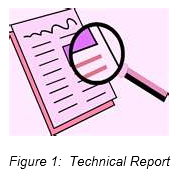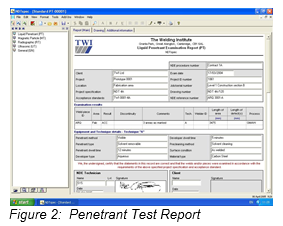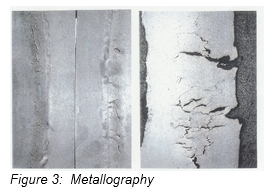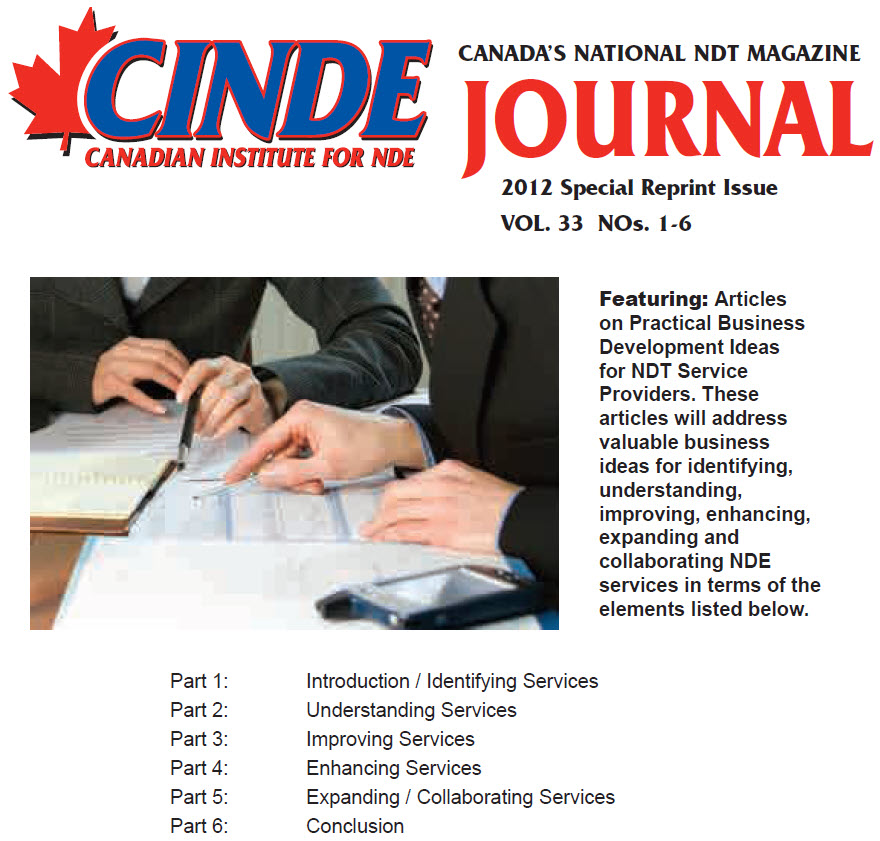Practical Business Development Ideas for NDE Service Providers – Part 1 of 6
Note: This article is the first in a series of six that appeared in the
Canadian Institute for NDE (CINDE) Journal throughout 2012. These articles address valuable business ideas for identifying, understanding, improving, enhancing, expanding, and collaborating NDE services in terms of the elements listed below.

- Introduction / Identifying Services
- Understanding Services
- Improving Services
- Enhancing Services
- Expanding / Collaborating Services
- Conclusion
Related: Effective Supplier Quality Surveillance (SQS).
INTRODUCTION
An article by author Mike Michalowicz on the Toilet Paper Entrepreneur (TPE) website titled Six Billion (NOT) Served[1], states that The traditional entrepreneurial approach is a statistical review of the numbers, but “analysis by the numbers” alone just doesn’t work. You must know what your customer’s values and expectations are at the most core level. Then when you set up shop, ensure that you are servicing the heck out those values and expectations.
That article was written for restaurateurs, so what can this mean to NDE service providers? Everything. What is the difference between a menu and a rate sheet? Nothing. This first article discusses valuable ideas for identifying your target NDE clients and then servicing their NDE wants and needs. This approach seeks to successfully understand and build collaborative client relationships, rather than competing with lower rates and then just waiting for service calls.
Non-destructive testing (NDT) and evaluation (NDE) is a multi-faceted business that provides many services to a range of clients in various industries. Services may be described as a scope or part of an assignment, job, project, task, or other work. Growing an NDE business by tapping into new markets requires not only entrepreneurial savvy, but also clear and effective communications. Opportunities for growth with new clients must not overlook your existing clients however, to whom additional services could be extended. The services may also be new or existing.
A target client may therefore be new, or an existing client using a competitor’s services that you could provide. The goal is to identify the services required by target clients, in order to develop ideal or flagship clients.
Ideal clients are those with you have a great working relationship, who provide clear requirements, appreciate your business, provide timely payment, and word of mouth advertising or referrals. Flagship clients are ideal clients that use your services preferentially or exclusively and provide a large volume of repeat business.
Problem clients may provide unclear requirements that result in problems from order entry to invoicing, and do not seem to appreciate your business. As a result, they demand more time and attention than the value of their business warrants. The best approach to this situation is to be positive and proactive by discussing their services needs with them, to identify specific problems and possible solutions, to improve the working relationship and develop another target client.
This series of articles, which begins with Identifying Services, will discuss practical and valuable ideas for identifying, understanding, improving, enhancing, expanding and collaborating NDE services for your target clients as a means of achieving business success.
IDENTIFYING SERVICES
Stephen R. Covey’s habit #2 from the book The 7 Habits of Highly Effective People[2] is to “begin with the end in mind”. The primary deliverable for an NDE business is the report; nothing more. Identifying services must mean not only what service will be provided but reporting the service that was provided. In another article that appeared in the NACE Inspect This magazine titled Reporting Our Value to Our Customers – More Meat with the Potatoes![3] author Terry Greenfield succinctly states that “Whenever the inspector’s reports are read, it should be clear and evident to the customer why it’s a benefit to have the inspector there on the job protecting their interests.” The same is as true for NDE reports as for coating inspection reports.
Reporting must not only provide basic code-related and project specific information with accept/reject results, but present as a high-value professional document that is clear and concise, with an appropriate level of detail that ‘supports and justifies the added cost of inspection.’ This can be done by documenting problem identification, mitigation and solution or completion, and unique insight or skills for identifying deficiencies and non-conformances, or other elements affecting the work to ensure that it conforms to the project specifications. This is possible where the service provided is consulting rather than strictly NDE, and the report is prepared or peer-reviewed by a qualified inspector, technologist, or engineer.


Including a sketch or a few photos is an excellent way to enhance reporting by providing additional information for immediate use and as a permanent record of service. It is advisable to take many photographs and use only the best for the report. Save all clear photos to the job file and state in the report that these are available for future use if needed.
Personalized client communications will provide high-value reporting with:

- reports according to client needs for hard or e-copies and transmittal by mail, fax, or email, with any copies
- follow-up emails or phone calls to confirm positive order placement, assignment or project status, and that the client’s needs are understood and serviced
- discussion of significant findings and job status at the workplace in person, or by timely phone calls
- emails or cover letter transmittals with reports that highlight accomplishments, qualifications, and job or project status and outcomes
- a personal thank you note, report copy or reference, and promotional or technical literature with invoicing
Finally, check out the fascinating website article by Mike Michalowicz The 7 Stupidly Easy Ways to use Behavioral Influence to Grow Business … Fast!.[4] His 7 tips are very thought provoking, as he describes their use and benefit to you and your company in passionate detail.
Note
This article was originally published in the Canadian Institute for NDE (CINDE) Journal 2012 Vol. 33 No. 1 and in the CINDE Journal 2012 Special Reprint Issue Vol. 33 Nos. 1 – 6. http://www.cinde.ca/journal/
About the Author
Roy O. Christensen is a Welding Engineering Technologist who has over 35 years’ experience with O&G, pipeline, and other projects. He has authored countless instructions, manuals, plans, proposals, reports, specifications, and other documents that continue to drive success for many projects. He is the founder of the KT Project that saves organizations significant money and time, by providing key resources to leverage expert knowledge transfer for successful project execution.
Contact
- Roy O. Christensen
- [email protected]
- +1 403.703.2686
Figures
- Technical Report www.parkerliveonline.com/wp-content/uploads/2011/02/report.jpg
- Penetrant Test (PT) Report www.twisoftware.com/images/products/ndtspec_nde_report.jpg
- Metallography www.powerfect.com/images/weld%20crack.jpg
References
- Michalowicz, M., ”Six Billion (Not) Served”, The Toilet Paper Entrepreneur, 2008, https://s3.amazonaws.com/mikemichalowicz/Website-Resources/Six-Billion-Not-Served.pdf
- Covey, S., “The 7 Habits of Highly Effective People”, Free Press, A Division of Simon and Schuster, Inc., New York, NY, 2004, ISBN 0-7432-6951-9
- Greenfield, Terry D., ”Reporting Our Value to Our Customers – More Meat with the Potatoes!”, Coatings Pro Magazine, Fall 2011 http://events.nace.org/education/inspectthis/images_inspect/InspectThis_Fall11.pdf
- Michalowicz, M., ”The 7 Stupidly Easy Ways to Use Behavioural Influence to Grow Your Business … Fast!”, The Toilet Paper Entrepreneur, 2011, http://www.toiletpaperentrepreneur.com/wp-content/uploads/NOTES-8-Behavioral-Techniques.pdf (dead link)

